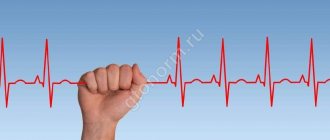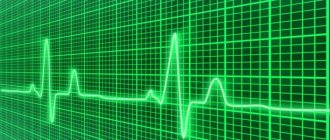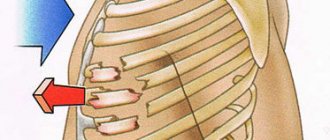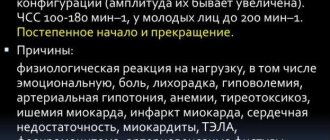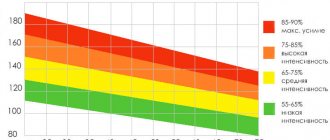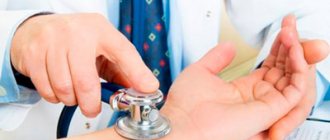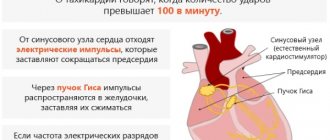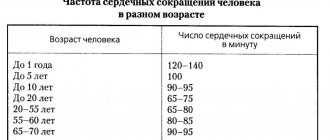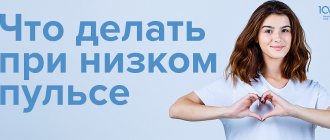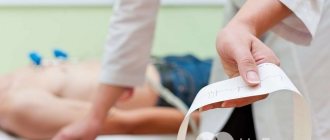What is a normal heart rate in children?
For each age, there are certain indicators that can be checked in pediatric cardiology in Saratov. During the appointment, the doctor listens to the heart, determines or excludes the presence of murmurs, and also counts the number of heartbeats. If necessary, an ECG or ultrasound of the heart may be prescribed. An experienced pediatric cardiologist in Saratov will draw the attention of parents to the fact that the heart rate decreases every year. If at birth 150-160 heart beats are considered normal, then by the age of 12–13 years this number is equal to 75 beats.
The pulse rate directly shows how the heart copes with its function and how efficiently it pumps blood. If there are too many contractions, the heart muscle may become fatigued and heart failure may develop.
When to see a doctor
If the pulse constantly deviates from the optimal value or various symptoms appear (chest pain, dizziness), it is recommended to visit a specialist for diagnosis. First you should contact a therapist - this is a general practitioner.
The specialist will conduct a survey, during which it is necessary to talk about the symptoms, if any. Next, important indicators are measured (pulse, blood pressure, temperature). Then the teenager's body is examined.
Next, the therapist can write a referral to another specialist, depending on the cause of the change in pulse. For example, if you suspect endocrine diseases, you should visit an endocrinologist.
After passing through all the specialists, a diagnosis is prescribed. For example, if a heart disease is suspected, a teenager may be referred for an electrocardiogram (ECG), 24-hour monitoring (Holter) and other procedures.
If a person’s well-being rapidly deteriorates or there are serious symptoms (fainting, severe heart pain), an ambulance should be called.
Why is it important to monitor your heart rate?
When visiting pediatric cardiology in Saratov, the specialist will pay attention to the fact that sometimes too high a pulse rate does not provoke painful sensations. It is extremely important to monitor the child’s behavior and reaction after physical activity, as well as after emotional outbursts. A small patient may complain of shortness of breath, headache, pain in the sternum radiating to the arm, as well as severe fatigue after:
- active physical exercise;
- long walks at a calm rhythm;
- walking up to low floors.
An increased heart rate in a child can also be observed after emotional stress. A pediatric cardiologist in Saratov will explain that laughter, as well as tears, prolonged viewing of cartoons, and strong emotional reactions can cause an increase in heart rate. It is important to measure the indicators after such a condition, and in addition, parents must make a lot of effort to check the frequency of contractions in the usual way.
Symptoms of increase and decrease
The normal heart rate of a 12-year-old teenager is between 55 and 100 beats/min. PS can deviate more or less. A decrease or increase is characterized by certain symptoms.
In the first case, the following symptoms may appear:
- coldness and paleness of the skin;
- increased irritability;
- worsening sleep;
- lethargic state;
- labored breathing;
- changes in blood pressure;
- dizziness;
- cold sweat;
- lack of coordination;
- nausea and vomiting;
- lack of air;
- chest pain;
- darkening of the eyes;
- mood changes;
- loss of consciousness;
- constant fainting;
- cardiac arrest (in critical cases).
When your heart rate is high, the following symptoms may occur:
- discomfort;
- rapid heartbeat - the process may be accompanied by jerking movements in the chest area;
- pain in the chest (symptom may be absent);
- anxiety, especially at night;
- headache;
- dizziness;
- sleep disturbance;
- difficulties with performing the usual load;
- changes in blood pressure;
- increased sweating;
- loss of consciousness.
Why does the heart rate increase?
During emotional or physical stress, adrenaline is released, which irritates the cerebral cortex. The hormone cortisol may also be released. Its excess causes insomnia and an overly alert state. It is especially dangerous if the child's heart rate increases in the evening, when he should lie down, relax and fall asleep. Adrenaline, entering the blood, causes its increased speed, and the heart begins to pump blood faster, which means it works with increased load.
Additional reasons why the heart rate may increase include:
- infectious and viral diseases suffered by a woman during pregnancy,
- natal injuries;
- acute illnesses of a child with increased body temperature;
- undergone surgical interventions.
A pediatric cardiologist in Saratov often diagnoses palpitations, other types of heart rhythm disturbances, heart murmurs, and blood pressure fluctuations. These symptoms can be caused by both diseases of the heart and blood vessels, and a number of other conditions: disturbances in the functioning of the endocrine system, nervous system, and kidneys. To identify the cause of the disease, a complete examination is required.
Sometimes for such an examination in pediatric cardiology in Saratov, the Holter heart rate monitoring method is prescribed, with the help of which the heart rate is recorded for 24 hours. Over the course of a day, a child’s emotional background and mood changes, there is physical activity, periods of sleep and quiet activities, and academic workload, which affects the functioning of the heart. And when deciphering the recording of the circadian rhythm, the pediatric cardiologist in Saratov sees what changes have occurred in the work of the heart.
Indicator table is normal
Compared to adults, teenagers have a faster heart rate. This is explained by intense metabolic processes and rapid contraction of the heart. The most frequent pulse is observed in newborns. As you get older, the rate gradually decreases.
The normal heart rate in children is shown in the table.
| Age category of the child | Normal heart rate (in beats/min.) | Average value (in beats/min.) |
| Up to 1 month | 71 – 171 | 141 |
| 1 – 12 months | 81 – 163 | 131 |
| 1 – 2 years | 95 – 155 | 125 |
| 24 years | 91 – 141 | 116 |
| 4 – 6 years | 87 – 127 | 105 |
| 6 – 8 years | 79 – 127 | 99 |
| 8 – 10 years | 69 – 109 | 89 |
| 10 – 12 years | 61 – 100 | 81 |
| 12 – 15 years | 56 – 96 | 76 |
| 15 years and above | 61 – 81 | 71 |
When exposed to physical activity, the indicator changes. In teenagers it can be 120 – 150 beats/min. The pulse should be measured not only after sports, but also after 5 – 15 minutes. from the end of classes. Normally, the blows should not become more frequent.
If a child is involved in professional sports, after training the heart rate may increase to 100 - 120 beats/min. That is, there is a general decrease in the indicator, the heart works less to obtain nutrients. During competition, your heart rate may increase. This is due to the combination of physical activity and emotional experiences.
You can roughly calculate the value beyond which your heart rate should not go beyond during sports. To do this, subtract the child’s age from 220. For example, a 12-year-old teenager’s heart rate during physical activity should not exceed 208.
The minimum value of the indicator is calculated according to a different scheme - from 220 it is necessary to subtract the child’s age and the number of heartbeats before performing physical activity, then multiply by 0.5 and add the heart rate before sports.
Using these formulas, it is possible to adjust the activity of athletes and children with excessive mobility. If after sports the child’s pulse is not higher than the upper limit and does not go beyond the lower limit, everything is normal, the load is not maximum.
Critical age periods
For young patients, there are critical periods during which an elevated heart rate is often observed. Most often, the child cannot explain exactly how bad he feels and what is the reason for such physiological changes. He feels pressure in his chest, dizziness, sometimes chills, and may even lose consciousness. You should not allow such frequent reactions to occur, and you should visit a pediatric cardiologist in Saratov as soon as you notice the first symptoms. A small patient may be afraid that his body reacted this way to running, watching his favorite movie and the fact that he received a gift that he had dreamed of for so long.
How to get it back to normal
Therapy is prescribed when the pulse deviates from the optimal value.
Treatment includes the following methods:
- medications;
- folk remedies;
- proper nutrition;
- physical activity.
In some cases, surgery is recommended. This happens if a change in pulse indicates a disease. For example, in the case of oncology, surgery may be performed. The need and type of intervention is determined by a specialist depending on the cause of the pulse deviation and the individual characteristics of the body.
If PS was slightly above or below the optimal value and returned to normal on its own, no therapy is required.
Medications
Medicines are not always used to treat abnormal pulses. For example, medications are not used if the situation has normalized with the help of folk remedies, proper nutrition, and sports. When a violation of the indicator indicates a disease, medications are often prescribed.
Specific medications depend on the degree and cause of the pulse deviation from normal. Additionally, the individual characteristics of the body are taken into account. If the pulse is high or low, the medications listed in the table may be prescribed.
| Group name | Action | List of funds |
| Sedatives | The drugs normalize a person’s emotional state and eliminate excessive nervousness. | Afobazol, Tenoten, Novo-Passit |
| Antihypertensive | Medicines lower high blood pressure. | Enap, Amlodipine, Bisoprolol |
| Cardiac glycosides | The drugs normalize the contractile and pumping function of the heart. Additionally, the products in this group restore metabolism, nutrition and cellular respiration. | Digoxin, Korglykon, Strophanthin |
| Antiarrhythmic | The drugs are used for heart rhythm disorders. | Cordarone, Sotahexal, Amiodarone |
| Tranquilizers | Products that have a calming effect. After taking it, anxiety, fear and any emotional stress disappear. This group of drugs is stronger than sedatives. Tranquilizers are sold from pharmacies strictly according to a doctor's prescription. | Phenazepam, Dormicum, Elenium |
| Diuretics | The drugs remove excess fluid from the body and are prescribed for high blood pressure. | Veroshpiron, Hydrochlorothiazide, Diuver |
| Thyroid hormones | Medicines are prescribed for hypothyroidism. | L-thyroxine, Euthyrox |
| Caffeinated | The drugs tone blood vessels, raise blood pressure and pulse. | Caffeine-sodium benzoate, Citramon, Coficil-plus |
| Vitamin complexes | The products restore the lack of vitamins and microelements. | Vitrum, Complivit |
| Immunomodulators | The drugs improve immune defense. | Immunal, Echinacea |
It is possible to prescribe additional symptomatic medications. For example, for pain, analgesics (Analgin, Baralgin) or non-steroidal anti-inflammatory drugs (Nurofen, Ibuprofen) are recommended.
Medicines must be prescribed by a specialist. The doctor takes into account the information specified in the instructions for use of the product. Next, he makes a decision on prescribing the drug.
Folk remedies
Folk remedies have a low likelihood of side effects due to their natural composition. The table shows recipes that can be used when the pulse deviates from the norm.
| Pulse | Herbal Recipes |
| High | Folk remedies include the following recipes: 1. Rose hips. For cooking you need to take 2 tbsp. chopped berries and 400 ml of hot water. Boil for 10 – 15 minutes, wait for it to cool and filter through cheesecloth. Take 1 glass per day. The recipe reduces heart rate and has a positive effect on the heart. 2. Valerian. To prepare the recipe, you need to take 1 tbsp. dry ingredient and 1 glass of hot water. Cook over low heat for 20 - 30 minutes, leave for 2 - 3 hours, filter through cheesecloth. Take 1 tbsp. 3 times a day. |
| Short | Natural recipes for low heart rate: 1. Vegetable mixture. To prepare, you need to take 500 g of chopped walnuts and 250 ml of sesame oil. Next, finely chop 4 lemons and add 1 liter of hot water. Mix everything, add 20 g of powdered sugar. Take 1 tbsp solution. 3 times a day. 2. Yarrow decoction. To prepare the recipe, you need to take 1 tbsp. herbs and 1 glass of hot water. Boil for 10 – 15 minutes, wait for it to cool, filter through cheesecloth. Take 3 times a day, 1/3 cup. |
Proper nutrition
Maintaining proper nutrition makes a person feel better and helps restore the heart rate to its optimal value.
The diet includes compliance with the following rules:
- eat 5 – 6 times a day with breaks of 3 – 4 hours;
- do not exceed the serving size of 300 g;
- exclude fried, fatty, salty foods;
- reduce the consumption of sweets and starchy foods;
- exclude alcohol, strong coffee and black tea - it is better to drink green tea, compote, juice;
- We should not forget about the drinking regime - at least 1 - 1.5 liters of clean still water per day;
- prepare dishes in the oven, steam and boiled methods;
- Vegetable soups and cereals should predominate in the diet;
- It is better to replace high-calorie foods with low-calorie ones - for example, buy chicken or turkey instead of pork.
Physical activity
Sport allows you to strengthen the human immune system and make you feel better. Physical activity does not involve too much stress. Enough charging in the morning. You also need to pick up an additional activity. For example, swimming, cycling, walking.
What are the future risks of a high pulse?
If you do not notice in time and do not contact pediatric cardiology in Saratov for adequate treatment, the child will experience frequent painful sensations over time, and in addition, he may develop associated disorders:
- with vessels, veins and arteries;
- with the nervous system;
- with hormonal background.
A pediatric cardiologist in Saratov, based on the monitoring results and tests obtained, will determine and make an accurate diagnosis, which will allow you to prescribe treatment, the effectiveness of which will not be long in coming. It is also important to record changes after a certain time in order to adjust the medication course and prescribe additional physiotherapeutic procedures, and choose the appropriate sport. It is important to take measurements immediately after physical activity of varying strength and intensity, after strong positive or negative psychological reactions. Pulse rate measurements after sleep are also important for a pediatric cardiologist in Saratov to determine the diagnosis and prescribe effective and appropriate treatment.
Over time, as the child grows up, it is necessary to teach him to monitor his pulse rate, especially after physical or emotional stress. There are drugs that can quickly restore the pulse rate, and in addition, maintenance therapy. Every year a little patient must learn to listen to his body, and an experienced pediatric cardiologist in Saratov will help with this.
Make an appointment with a cardiologist
Choose a doctor
How to determine
The pulse of a teenager (12 - 18 years old) must be monitored to compare it with the norm.
Measurements can be taken at the following locations:
- wrist;
- ulnar artery (slightly below the elbow);
- elbow bend;
- armpit;
- temple area;
- neck (carotid artery);
- lower jaw and corner of the mouth;
- inner thigh;
- bend of the leg (below the knee);
- foot.
The most common places where the pulse is measured are the extremities (wrist) and neck.
To monitor the indicator at home, the following methods can be used:
- Palpation. You should choose the hand on which the pulsation is better. If everything is the same, then you need a limb close to the heart. You need to find a point that has a pronounced pulsation and press it with your ring finger. Next, count the number of blows in 1 minute, compare the result with the norm. You can use another method - count the number of beats for 6 seconds, then multiply the number by 10. If it is impossible to hear the pulse on the wrist, measurement on the carotid artery is allowed. To do this, you need to sit or lay the person down and press on the artery with your index finger. Next, count the number of beats in 6 or 60 seconds. In the first case, multiply the indicator by 10.
- Using an electronic tonometer . Modern devices can count pulse together with measuring blood pressure. The result is displayed on the tonometer screen.
- Heart rate monitor. The device is designed to analyze heart rate, monitor the load and functionality of the heart. There are different types of heart rate monitors - on the chest, on the finger, on the arm.
Before measuring, you must adhere to the following rules:
- exclude physical activity;
- rest before measurement for 5 – 10 minutes;
- eliminate stress 1 – 2 hours before measurement;
- stop smoking 2 - 3 hours before measuring your pulse;
- do not drink strong coffee or alcohol;
- do not measure your pulse after a hot bath or swimming;
- Do not eat heavily or fast before taking measurements;
- you need to take measurements 1 – 2 hours after waking up;
- remove tight clothing, as it can compress the artery.
Heart rate in premature newborns
Babies who are born prematurely have a harder time adapting to their environment. Their organs and systems are not yet fully formed. Some indicators differ that are characteristic of those newborns who were born on time.
So, in a premature baby the pulsation is even higher than in a normal newborn. The number of beats can reach 170. This is explained by the fact that the blood vessels and heart are not yet strong enough, so the functioning of the system is difficult.
Premature babies are more susceptible to illness and are sensitive to irritants. Therefore, after the birth of the baby, you need to limit yourself from noise, bright lights and loud sounds. Over time he will adapt to this, but he needs more time.
Possible complications
It is necessary to find out the cause of the constant high or low pulse and begin timely treatment. If this rule is ignored, there is a high probability of complications.
Possible consequences:
- loss of consciousness;
- impaired blood circulation in the brain and other organs;
- the formation of blood clots in the heart;
- heart failure;
- death.
Pulse is a criterion by which the state of human health can be determined. PS has different characteristics - frequency, rhythm, content. Most often, the pulse is detected at the wrist or neck. After measurement, the value is compared with the norm. In adolescence (12–17 years), the pulse is slightly higher than in adults. PS may deviate from the optimal value up or down.
This indicates physiological (stress, poor diet, being in an unventilated area) or pathological (cardiovascular, endocrine diseases) reasons. If the pulse deviates from the norm for a long time, you need to visit a specialist.
The doctor will prescribe diagnosis and treatment. The most important thing is to reduce the likelihood of complications. To do this, you must follow your doctor's recommendations.
Prognosis and prevention
The prognosis for bradycardia in a child depends on its cause and severity. In some cases, it is enough to adjust lifestyle or hormonal status to normalize heart function, while in others complex treatment and lifelong monitoring are required. Prevention of the development of pathology includes, first of all, teaching the child to a healthy lifestyle, prevention and timely treatment of diseases that can provoke this condition.
If your child or teenager is experiencing bradycardia, do not wait for the disease to progress; make an appointment with the pediatric cardiologists of the SM-Doctor clinic. You will receive a comprehensive examination, modern and effective treatment if necessary, as well as regular supervision by an experienced specialist.
What to do if your readings are low
If low heart rate is not caused by pathological processes, then no action needs to be taken; often this condition is generally considered normal (for example, for professional athletes). But if there is a sudden drop in heart rate, the teenager’s vision becomes dark, or general weakness appears, then you can correct your well-being by drinking a cup of coffee or the strongest possible black tea. If after 3-5 minutes the pulse does not return to normal, then an ambulance should be called.
If an increase in heart rate often occurs for physiological reasons, then its decrease is almost always associated with pathological changes. Bradycardia is a reason to consult a doctor and undergo examination, diagnosis and further treatment.
What is bradycardia?
With tachycardia, the pulse is increased, and bradycardia is the opposite phenomenon. We can talk about the presence of this condition if the pulsation is less than 60 beats per minute. There are also natural and pathological causes. Such indicators are observed in the sleep phase and in people who play sports professionally.
Pathological bradycardia is observed in people with heart disease, with heart attacks and poisoning, with age, with ulcers and other diseases.
The main symptoms of bradycardia: dizziness, weakness, cold sweat, lightheadedness.
